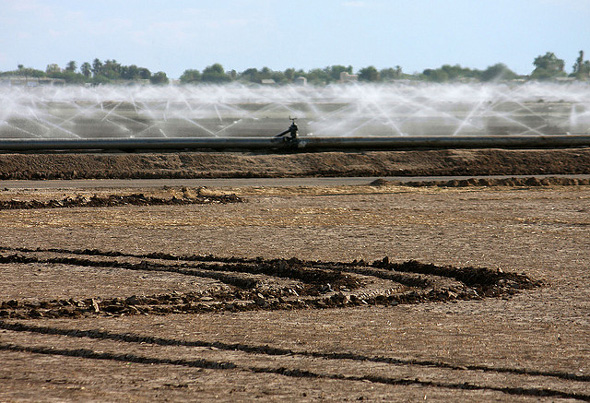-
‘The Christian Science Monitor’ Explores the Global Water Crisis: Should We Charge More for Water?
December 6, 2012 By Schuyler Null
“There is as much of that water on the planet today as when the first amphibian flopped ashore; as much as when the ancient Greeks divined the future in the babble of brooks,” writes William Wheeler in The Christian Science Monitor. “So why do experts in science, economics, and development warn that a ‘global water crisis’ threatens the stability of nations and the health of billions?”
Wheeler’s comprehensive article takes a new tack than most media coverage of water scarcity by focusing on historical causes, with a particular focus on changes in ground water extraction over the last 60 years or so.
“A few thousand years ago, when civilizations first branched out from rivers, they populated areas where they could draw from that savings in the form of ground water 20 to 30 feet below the surface,” he writes.
Globally, this was the norm until the 1950s, when fossil fuel energy became widely available to allow pumping water from ever-deeper depths. Ever since, humanity has increasingly lived beyond the margins of its renewable water supply.
In ancient fossil aquifers – in the Great Plains of the United States, the North China Plain, or Saudi Arabia – water levels are not recharged by rainfall. Elsewhere, as in northern India, ground water is used faster than it can be replenished. According to the United Nations, ground-water extraction globally has tripled in the past 50 years, during which time India and China’s ground-water use has risen 10-fold.Misconceptions About the “Global Water Crisis”
But Wheeler also describes current and future trends that will affect water availability and quality, including climate change, where Ohio University professor and ECSP senior advisor Geoff Dabelko weighs in.
“The term ‘global water crisis’ can be misleading,” Dabelko tells Wheeler. “It tends to imply that there’s just one kind of crisis – a water shortage. The kind of dead-cow-carcass-in-the-desert image that global ‘water crisis’ evokes is very real for some people. But there are so many dimensions.” Too much water (flooding, sea level rise, or more extreme storms) and more variability in when it arrives can be just as deadly as too little, he says.
Another misconception about the global water crisis is that “it’s somebody else’s problem, on the presumption that we’re wealthy enough to just deal,” Dabelko told Wheeler:
[S]o climate change, it’s Bangladesh. Global water crisis, it’s the Horn of Africa. It’s somebody else’s problem, and those [who] can’t afford something are going to be the ones that suffer. Rather than understanding, ‘Yes, it’s global. Yes, it’s a crisis. But it’s also very meaningful for us even if we can insulate ourselves from the changes in food prices.’
The role of food prices in translating local or regional water problems into global problems is fairly well established, thanks to the work of Marc Bellemare and others who have studied the links between food prices and political instability. Water as a national security issue – whether via competition over scarce resources, neighbors dealing with the effects of water-displaced people, or transboundary rivers – is another angle where there is quite a bit of research. The National Intelligence Council released a full assessment on the topic earlier this year at the Wilson Center, for example.
“Everyone Should Pay More for Water”
Upmanu Lall, director of Columbia University’s Water Center, suggests to Wheeler that today’s situation is actually much worse than many understand, but that certain changes will come quickly and make a large impact. The biggest, he argues, is that “everyone – from the home-owner watering the lawn to big industry and agriculture – should pay more for water.”
“Water is a part of everything we do: It feeds crops, powers cities, cools computer servers, and is key to the manufacturing of everything from clothes to cars,” Wheeler writes. “The billion more people expected on the planet by 2025 will increase water demand for all of those functions.”
But for societies to respond, Lall suggests, it may take “instability, conflict, and economic stagnation” to prod them into action.
For the United States, Lall tells Wheeler a national water policy that “incorporates forecasts, trading mechanisms, options, and the coordinated use of both surface and ground-water resources” is necessary.
For example, Lall points out that some states (Arizona, California, Idaho, and Texas) “have water banks that facilitate leases between rights-holders and users. But since these water banks don’t incorporate forecasting, they fail to make deals until a drought begins.”
—
What do you think? Is the “global water crisis” accurately described? How much of it is a “now” problem and how much is tomorrow’s? Is a national water policy, like Lall suggests, viable in the United States? Will it take a crisis for serious change?
Sources: The Christian Science Monitor.
Photo Credit: “Irrigation, San Luis Field,” courtesy or flickr user cobalt123.
Topics: Africa, agriculture, Asia, economics, environment, environmental health, food security, media, natural resources, On the Beat, population, security, U.S., water
 A Publication of the Stimson Center.
A Publication of the Stimson Center.



